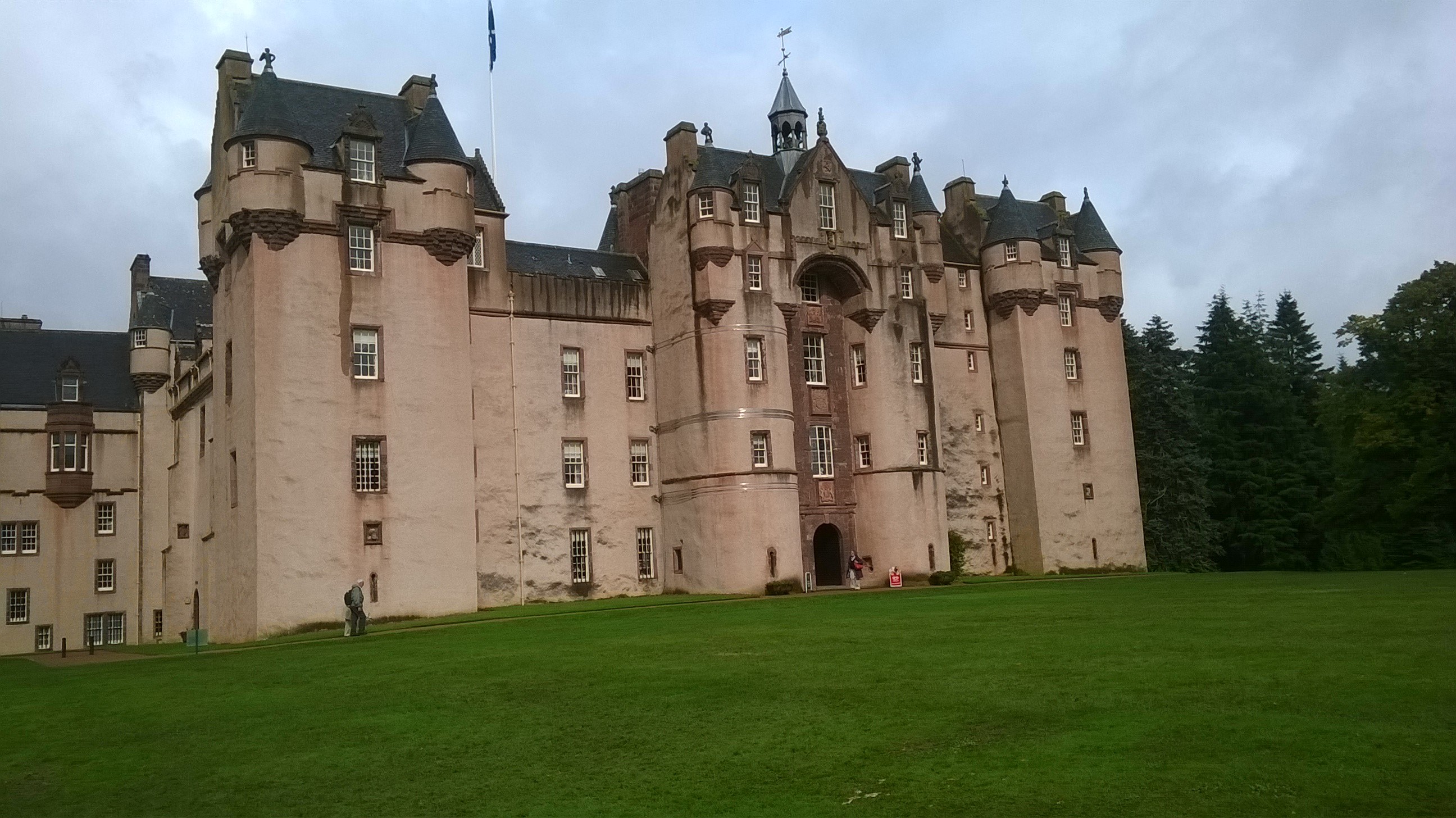The recent visit to Aberdeenshire and Perthshire is reviewed here by our Curator, James Lomax. The society regularly holds visits and study days for members. To see what is currently organised please visit the events page, or to become a member of the society please see the membership page.
Our route north took us first to Dalemain, Cumbria, the ancient house of the Hassell family which was partly Georgianised from about 1750. Its great interest lies in the Chinese Drawing Room (maybe once a ground floor dressing room) with its 16 sheets of Chinese ‘garden’ wallpaper supplied by Bromwich in 1756 at 13/-d a sheet. It was supplemented the following year by a magnificent carved rococo chimneypiece complete with writhing dragons, and a suite of armchairs and side chairs with exotically fretted arms and legs, supplied by one Nathaniel Hedges. The Chinese theme continued with an export porcelain service in blue and white marked on the back of one of the plates ‘Hassell’. In 1774 an impressive group of Gillows furniture arrived at the house, mainly for the dining room (table, fan-back dining chairs, cellarets and a pair of fine Gothick plate carriers). Upstairs there was a Grendey-style clothes press with shaped inset panels, Gillows night tables etc.
The southern contingent of our group met us at 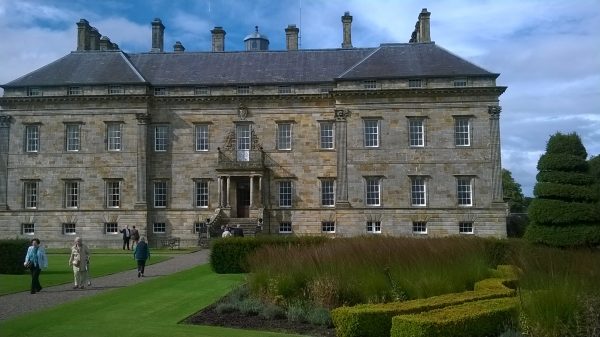 Perth and the next day we set out for Kinross House, the first ‘classical ‘country house in Scotland, built for himself by the royal surveyor and entrepreneur Sir William Bruce. We were given an excellent introduction and tour by Dr John Lowrey of Edinburgh University who discussed the building history, its uses and some of the craftsmen involved. The various apartments have been somewhat altered but the fine staircase with its carved scrolling balustrade and its answering painted dado are intact. The visit culminated in the great Saloon in the centre of the first floor. The contents of Kinross have been largely dispersed by the Montgomery family but its new owner has been able to retain a number of pieces as well as undertaking the huge job of restoring the building and its gardens extremely successfully.
Perth and the next day we set out for Kinross House, the first ‘classical ‘country house in Scotland, built for himself by the royal surveyor and entrepreneur Sir William Bruce. We were given an excellent introduction and tour by Dr John Lowrey of Edinburgh University who discussed the building history, its uses and some of the craftsmen involved. The various apartments have been somewhat altered but the fine staircase with its carved scrolling balustrade and its answering painted dado are intact. The visit culminated in the great Saloon in the centre of the first floor. The contents of Kinross have been largely dispersed by the Montgomery family but its new owner has been able to retain a number of pieces as well as undertaking the huge job of restoring the building and its gardens extremely successfully.
Our journey north took us next to Crathes Castle, the romantic 16th century tower house of the Burnett family, now a property of the NTS. Christopher Hartley introduced us to the house and its owners and led us to some of its most outstanding features notably the painted ceilings with their emblematic figures, mottoes and heraldry, and the Aberdonian furniture: the spectacularly carved full tester bed made for Alexander and Katherine Burnett dated 1594, and the earliest dated chairs also made for them and dated 1597.
Next day we travelled north to Duff House, the magnificent Baroque / Palladian house built for the Earl of Fife by William Adam in his richest decorative style and completed by his son. For years the house remained a forlorn empty shell until it was rescued in the early 1990s and opened as a country house art museum with paintings loaned from the National Gallery of Scotland and furniture from the Erskine Collection formerly at Dunimarle Castle and elsewhere. Among the highlights were Italian and French seat furniture from the Cardinal Fesch collection, given to him by his nephew Napoleon; Gobelins tapestries from the Moor Park suite made for Sir Laurence Dundas; and the pair of ormolu candelabra by Paul Storr made for the 4th Earl of Fife from a design by C.H. Tatham.
The afternoon took us to Leith Hall, a much altered and enlarged tower house where we were very pleasantly surprised to find some exceptional furniture: a set of 1760s mahogany splat back chairs with tassels, a set of three beautifully carved side chairs with contemporary gross and petit point embroidery with flowers and animal scenes apparently a gift to the NTS and shared with Culzean Castle. A real surprise was to find a plain Regency writing / dressing table made for Napoleon’s exile on St Helena by George Bullock, presumably acquired a ‘souvenir’ at the Longwood Sale in 1822.
Our first stop the following day was Fyvie Castle, the 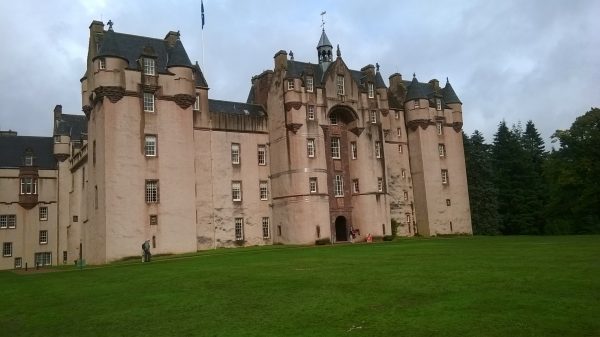 great tower house whose present dramatic appearance is largely due to Sir Alexander Seton who bought the estate in 1596. It was forfeit after the first Jacobite rising and acquired by the Gordons of Haddo as a house for a younger son of that house. It was sold in 1889 to a neighbour, Alexander Leith, who had made a great fortune in the steel industry in the United States and had married an American heiress. He renovated the castle and installed his magnificent collection of paintings, mainly 18th and early 19th century Scottish and English portraits and these are the chief glories of Fyvie today. Among the richly carved baronial furniture were some interesting items. A set of particularly elaborate Chippendale-style splat back armchairs and sidechairs dispersed around the house turned out to be probably American since they were spotted in an old photograph of the Leith’s New York apartment. Other American furniture identified by Christopher Hartley included a full tester bed with a dismountable canopy for summer use.
great tower house whose present dramatic appearance is largely due to Sir Alexander Seton who bought the estate in 1596. It was forfeit after the first Jacobite rising and acquired by the Gordons of Haddo as a house for a younger son of that house. It was sold in 1889 to a neighbour, Alexander Leith, who had made a great fortune in the steel industry in the United States and had married an American heiress. He renovated the castle and installed his magnificent collection of paintings, mainly 18th and early 19th century Scottish and English portraits and these are the chief glories of Fyvie today. Among the richly carved baronial furniture were some interesting items. A set of particularly elaborate Chippendale-style splat back armchairs and sidechairs dispersed around the house turned out to be probably American since they were spotted in an old photograph of the Leith’s New York apartment. Other American furniture identified by Christopher Hartley included a full tester bed with a dismountable canopy for summer use.
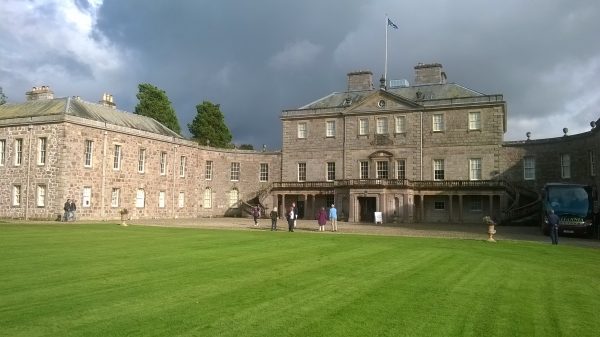 We then proceeded to Haddo House, the Palladian mansion built by William Adam for the 2nd Earl of Aberdeen but modernised in the early 1880s by the 7th Earl and his wife. Her father had employed the Adam-revival specialists Wright and Mansfield at his house at Guisachan near Inverness and at Brook House, Mayfair. They were the natural choice for Haddo which is perhaps their finest surviving commission. We admired the exquisite satinwood
We then proceeded to Haddo House, the Palladian mansion built by William Adam for the 2nd Earl of Aberdeen but modernised in the early 1880s by the 7th Earl and his wife. Her father had employed the Adam-revival specialists Wright and Mansfield at his house at Guisachan near Inverness and at Brook House, Mayfair. They were the natural choice for Haddo which is perhaps their finest surviving commission. We admired the exquisite satinwood 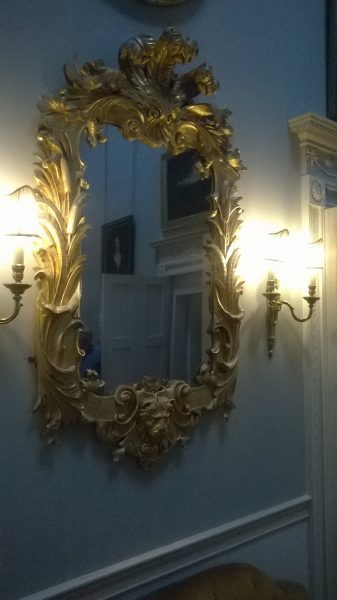 and giltwood pieces for the drawing room, the tall chimney glasses (reminiscent of Chippendale junior), and the mahogany furniture for the dining room. The library is without doubt their piece de resistance with its two Wedgwood encrusted chimneys, the cedar bookcases inlaid with ebony decoration in the Adam style. The great library writing table is the most elaborate with ebony rams’ heads and flutings and black and white Wedgwood medallions inset into the doors. Elsewhere in the house there was much to admire: a fine pair of palmbranch mirror frames surmounted by Prince of Wales feathers possibly by Thomas Vardy, and a tea table inlaid with brass stinging in the style associated with John Channon and others.
and giltwood pieces for the drawing room, the tall chimney glasses (reminiscent of Chippendale junior), and the mahogany furniture for the dining room. The library is without doubt their piece de resistance with its two Wedgwood encrusted chimneys, the cedar bookcases inlaid with ebony decoration in the Adam style. The great library writing table is the most elaborate with ebony rams’ heads and flutings and black and white Wedgwood medallions inset into the doors. Elsewhere in the house there was much to admire: a fine pair of palmbranch mirror frames surmounted by Prince of Wales feathers possibly by Thomas Vardy, and a tea table inlaid with brass stinging in the style associated with John Channon and others.
Next day we proceeded south to Glamis Castle, the ancient castle of the Lyon family, spectacularly rebuilt by the third earl after the Civil War. Despite our visit being hurried owing to the large numbers of visitors we were able to identify a number of exceptionally interesting furnishings which would repay further study: in the Crypt – chairs with gilt leather and turkey work upholstery and a magnificent brass encrusted leather trunk; in the Drawing Room – a superb sequence of late 17th century portraits in their Sunderland fames, a number of Japanese lacquer cabinets and chests on frames, at least two Antwerp or Augsburg cabinets on stands, one with embossed gilt metal figurative panels, the other standing on three part-gilded blackamoors, with painted ivory (or marble ?) panels now replaced with scenes of Glamis and its environs painted on wood. The chapel with its decoration by de Wet and stained glass by Kempe is exceptional, while the Billiard Room contained a suite of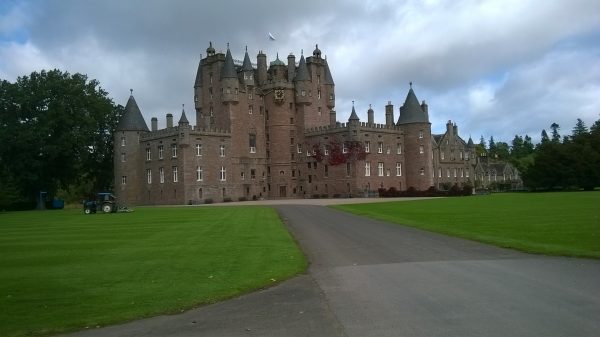 ebonised chairs and tables with painted and gilt decoration from c1800. King Malcolm’s Room is clad with hangings with 17th century applique birds, animals and flowers clearly from a bed, possibly the one in the King’s Room with a japanned tester clad in gilt carvings and a valance with embroidered and couched decoration. We would have welcomed a more leisurely and informed visit which might have yielded more interesting and definitive results.
ebonised chairs and tables with painted and gilt decoration from c1800. King Malcolm’s Room is clad with hangings with 17th century applique birds, animals and flowers clearly from a bed, possibly the one in the King’s Room with a japanned tester clad in gilt carvings and a valance with embroidered and couched decoration. We would have welcomed a more leisurely and informed visit which might have yielded more interesting and definitive results.
We were joined for our penultimate visit by Dr David Jones who was generous in sharing his great knowledge of the furniture at Blair Castle, the ancient castle entirely Georgianised by the 2nd Duke of Atholl who bought a great quantity of furniture from different suppliers mainly in the 1750s. We were able to admire the two suites of chairs by John Gordon, one with fishscale (or dophinscale) carving, the four great rococo pier glasses and three tables by George Cole, mahogany pieces by William Masters and James Cullen, the suite of Louis XVI gilt chairs in the Drawing Room by Chipchase and Lambert, in addition to earlier pieces by Hodson and the great bed made for the family’s apartment at Holyrood c1700 but brought here shortly afterwards. A great feature is the group of furniture made in local broomwood, including a bureau bookcase by George Sandeman of Perth. Plenty of superb furniture remains unattributed: picture frames and sconces close to Chippendale Director patterns, charming painted furniture in a simple Hepplewhite manner made for the Hermitage at Dunkeld, a superb serpentine lacquer commode, not to mention the Continental pieces including the great Piedmontese rosewood and walnut writing cabinet spectacularly inlaid with mother of pearl ruin scenes. The pair of inlaid larchwood cabinets with glen tilt marble tops by George Bullock and a beautiful marquetry centre table by Baldock competed the roll call of illustrious British furniture makers of the golden age.
Blair contains the earliest surviving documented furniture by Chippendale: the pair of torcheres, ‘neatly carved and painted white’ but now gilt, costing seven guineas and a pole screen at £3. One of the torcheres was shown to us by David Jones in the private library juxtaposed with a contemporary ‘copy’ probably by the Edinburgh wright John Thompson. We were divided into groups to test our ‘connoiseurship’ and identify which was by whom. There was much discussion but fortunately everyone was correct in their verdict. We also examined and commented on the invoice for the broomwood bureau by Sandeson and noted the different components he had charged for in building up his itemised bill for twenty guineas. We are very grateful to David for organising this interactive engagement for us.
Our final visit next day took us to Marchmont House in the Borders. This great Palladian house was built c1750 for the third Earl of Marchmont, by an architect unknown but perhaps from a plan by William Adam or James Gibbs with one Thomas Gibson acting as executant. The superb rococo plasterwork is by Thomas Clayton and the house was extended and enhanced by Sir Robert Lorimer from 1914. After the family’s departure and years of institutional use it was brought back into private hands in 2007, and over the past four years has been entirely restored by the new owners and is being filled once again with specially acquired works of art. We were led by Francis Raemakers, the curator, who explained that the rooms on the piano nobile have historic paintings of a grant tour theme and furniture from recent important sales, including superb tapestries from the Lingholme Collection. We admired a pair of John Gordon ‘fishscale’ chairs from Ditton Park – identical to the Blair Castle examples we had seen the day before; pier and chimney glasses by William Mathie similar to examples at Dumfries House, torcheres from the Lonsdale collection and much else. Particularly rewarding for the new owners is the repatriation of a magnificent embroidered heraldic firescreen with the arms of the 3rd Earl, crewel work covers for a pair of sofas, and a full tester bed by Lorimer. On the upper floor is a complete gallery of the Arts and Crafts movement which continues to expand almost daily: especially furniture by the Cotswolds masters and Glasgow and Edinburgh fin de siecle makers, pottery from Linthorpe, Pilkingtons, Burmantofts, and de Morgan, metalwork by Jeckyll and Dresser. A screen by Walter Crane had just arrived and was awaiting conservation. We left feeling we had just scratched the surface of a great collection in the making.
Our special thanks go to Tony Mills for managing all the complex arrangements of this visit (his last) and to Christopher Hartley and David Jones for their special insight.

